SUNDAY
MARCH 31 - 2019
Brook
Meadow
Jean and I had
a walk through the meadow this morning, a bit chillier
than previously, but still very pleasant spring
weather. Best sighting was a cluster of new Meadow
Foxtail grass spikes on the north meadow - they
are early but not specially. In a few weeks their
graceful cylindrical flower heads will dominate the
north meadow.

We heard two
Blackcaps singing, one in the north end of
Palmer's Road Copse and the other from bushes near the
Lumley gate. That is a good start for late March.
I spotted the first
flowers of Cow Parsley on the edge of the path
just behind the main seat. We can look forward to
walking through an avenue of these aromatic flowers on
the main river path later in the spring.
We stopped to admire
the mass of yellow male catkins on the Grey Willow
on the edge of the Lumley area, making a nice
contrast with the very tall Black Poplar tree nearby.

Other
observations
The Mute
Swan was off the nest on Peter Pond when we
passed, but we could not see the eggs which the pen
sensibly had covered before going for a swim on the
pond.
Coming back home
through Bridge Road car park as is my custom, I was
delighted to find the first Cuckooflowers of
the year on the wayside verge in Bridge Road car park.
It will be interesting to see what sort of crop we get
this year. Numbers have been falling since the heady
days of 2012 when I counted nearly 700 flowering
plants. Last year I only got 157.

Pompey
win the cup
I could not
let today's blog go without mentioning the great
victory by Pompey today. All thee of my sons and my
three grandsons (all avid Pompey fans, like myself)
went up to Wembley today. They saw a memorable game in
which Pompey came from behind to win the Check-a-Trade
cup on penalties against Sunderland. 40,000 fans from
each club created a wonderful atmosphere.

I was not well enough
to go, but thoroughly enjoyed watching it on Sky.

Well done lads and now
for promotion!

SATURDAY
MARCH 30 - 2019
Hermitage
Millponds
There has
clearly been things happening on Slipper Millpond
since I was last there. Today, a Canada Goose was
sitting snugly and hardly visible on a nest on the
centre raft. You can see its white head just the right
of the two gulls in the photo.

Meanwhile its mate was
standing, as if on guard, on the south raft, which, of
course, has been the nesting site of the Great
Black-backed Gulls for the past two years.

There was no sign of
the Gulls anywhere on the pond and it looks as if they
may have been sent packing. I am constantly surprised
that a pair of apparently 'mild-mannered' Canada Geese
can drive off such a transparently fearsome pair of
large Gulls. I shall keep an eye on the situation.
All was not so
peaceful among the Coots either, with one of
their typical breeding season scraps taking place
between, I suspect, two males over a female.
I spotted my first
flowering of Cow Parsley of the year on the
east bank of Slipper Millpond.

Over on Peter Pond all
seemed peaceful with the pen Swan tending to her
nest in the reedbeds on the north west corner of
Peter Pond in which I could see at least eggs when she
stood up. Assuming another 6 eggs are laid in the next
12 days, then hatching should take place 36 days after
the laying of the last egg, taking us to May 17th.

Brook
Meadow
I walked back
home through Brook Meadow where I kept a special look
out for butterflies on this very warm spring morning.
I had two firsts for Brook Meadow for this year, a
Peacock rested briefly on the path around the
Lumley area and a Small Tortoiseshell around
the Butterbur flowers in the area beneath the main
seat, stopping to take nectar. The Small Tortoiseshell
was particularly welcome as I did not have a single
sighting of this beautiful butterfly at all last year
on Brook Meadow - and hardly at all elsewhere. Small
Tortoiseshell is vulnerable to having bad seasons, but
hopefully this early sighting presages a better
season.
Walking back along the
main river path I spotted a tiny metallic blue beetle
on the edge of a nettle leaf. My tentative guess is
that it is a Chrysolina leaf beetle, possibly
C. herbacea (Mint Leaf Beetle)

Wheatear
Christopher
Evans reminds us that this is a good time of the year
to see Wheatear passing through our region on their
way to the breeding grounds further north. Christopher
captured this photo of a handsome male Wheatear on the
sea wall north of the Cobnor Activity Centre. He said
the bird flitted about for sometime before settling
down in a position near enough to get a good
image.

Hydrobia
Shells
Regarding the
millions of tiny Hydrobia shells washed up on Emsworth
east beach I have, as suggested by Chris Cockburn,
looked at the shells very closely with the microscope
and there's definitely no movement and no sign of
life.
I asked Chris two
extra questions and here are his answers (thanks
Chris):
1. How is it they have come to be washed up in such
vast numbers at this time?
Essentially, lots of dunlins - 10000 plus for 3 or 4
months - equals incredibly high numbers of consumed
prey. Re your first question, my response is empirical
and definitely not scientifically-based. It is based
on my observations in Langstone Harbour starting from
the late 1960s (from the seawall at FM,
seawall/shorelines at Portsea Is, Broadmarsh,
Southmoor, West Hayling and from the shores of the
harbour's islands). There are shore sites where there
are consistent accumulations of Hydrobia Spp shellfish
shells. I can only guess that tidal currents and
sheltered and forms are the principal causes for these
accumulations.
2. How do Dunlin go
about consuming these tiny creatures?
Dunlins and other waders probe the mudflats with their
sensitised bills looking for prey - I would guess that
like black-tailed godwits etc they use surface tension
of the wet shellfish to draw the prey up their bills
and then to extract and digest the soft nutritious
contents of the inverts before excreting the empty
shells. Given the small size of the prey, a satisfying
meal will probably require a lot of shellfish. Of
course, with relatively large amounts of water taken
in with the creatures, squirting becomes" de rigour"
but given the rapid probing done by dunlins, their
squirting would be very hard to capture in a photo.
FRIDAY MARCH
29 - 2019
Langstone
and Warblington
Peter
Milinets-Raby visited Warblington and Langstone Mill
Pond 9am to 11:15am - low tide throughout. Lovely
weather - probably too nice for migrants, but he did
see three great species this morning, includung
Bearded Tits. How exciting. Maybe they will come over
to Peter Pond where we have some great reedbeds.
Here is Peter's report
. . .
The hay dump held just 1 Water Pipit and 2 Pied
Wagtails. The dump is fast drying out and this maybe
the last time I see anything here until it rains - if
it rains!
The reduced Linnet flock were perched in a tree and I
counted only 107 of them, so a 100 have left.
A handsome male Blackcap (my first of the year)
was singing along the hedgerow with 3+ singing
Chiffchaff.
In the mini reed bed
behind Conigar Point I had 2 male and a female
Bearded Tits. They were calling frequently, they
flew around a couple of times, then gave me some
fantastic views perched up in the reeds, then they
left west with lots of calling. I have only ever
recorded this species on one other occasion - a male
on October 2nd 2013 in the same spot!
There was very little
off Conigar Point with 5 Red Breasted Mergansers and 3
Shelduck.
Off Pook Lane the third good bird of the day - two
Whimbrel - were observed feeding along the rocky
shoreline with an Oystercatcher. These were my
earliest ever recorded. Also were 4 Shelduck, 11 Brent
Geese, 4 Lesser Black-backed Gulls, 2 Med Gulls and 37
Black-tailed Godwits.
On Langstone Mill Pond were 11 Little Egrets getting
very excited with lots of displaying and stick
collecting. Two individuals were already sporting rosy
red feet!
Rewilding
the Isle of Wight
Exciting
things are afoot on the Isle of Wight. Following
proposals to reintroduce White-tailed Eagles to the
Island, the Hampshire and Isle of Wight Wildlife Trust
have recently produced plans to create a wilder Wight,
'an island where nature can truly flourish'. As part
of this they want residents to help in making their
own environments - gardens, farms, streets, businesses
- more in tune with nature.
To learn more
about the campaign and how you can get involved,
download their manifesto for a Wilder Wight at
https://www.hiwwt.org.uk/our-strategy

Yesterday's launch of
the scheme included talks by
Derek Gow - a water vole expert and strong
advocate for beaver reintroduction http://www.watervoles.com/
Charlie Burrell
- the owner of the Knepp estate in Sussex, who has
put rewilding into action https://knepp.co.uk/home
Both speakers made the
case that the reintroduction of beaver was essential
for wetland management. Wow! Beavers on the Isle of
Wight!
WEDNESDAY
MARCH 27 - 2019
Great
Crested Grebe
Chris Oakley
had the good fortune to see a Great Crested Grebe on
the town millpond this morning.

Great Crested Grebe is
an occasional visitor to the millpond, not nearly as
common as the Little Grebe and the Red-breasted
Merganser. It is the first I have heard of this winter
period, though they often do turn up in early spring,
presumably passing through on their way to breeding
grounds. The bird's plumage is certainly rather mixed,
partially still in winter plumage but not in full
breeding plumage.
Warblington
Peter
Milinets-Raby had another stroll around Warblington
this morning. Very quiet, that in-between time,
waiting for spring to properly happen (9am to 10:23am
- low tide)
Hay Dump: 3 Water Pipits - one flew up into the nearby
tree for a photo opportunity - it has lost all its
streaking and as close to summer plumage you are
likely to see in this country. 2 Pied Wagtails,
Chiffchaff singing from hedge, 2 Linnets perched on
top of hedge. Skylark heard singing.

Field behind Conigar
Point: 200+ Linnets (same flock as the other day). 2
Meadow Pipits.
Conigar Point: 2 Shelduck, 3 Lesser Black-backed
Gulls, 2 Med Gulls over, Chiffchaff singing from
Tamarisk hedge.
Off Pook Lane: 3 Red Breasted Merganser, 6 Teal, 7
Black-tailed Godwit, 3 Brent Geese, 3 Shelduck, 1
Greenshank, 6 Med Gulls over, 3 Buzzards - calling and
displaying with spectacular dive bombs, 1 Sparrowhawk
on a hunting run, 1 Kestrel.
TUESDAY
MARCH 26 - 2019
Brook
Meadow
What a
glorious spring morning for a walk through Brook
Meadow.
I started at Palmer's Road Copse for a change. I
spotted a tiny clump of white Sweet Violets in flower
at the northern entrance to the riverside path through
Copse. I have seen them there in previous years.
Further along the path was a nice clump of Summer
Snowflake in flower on the west bank of the river.
This is also a regular at this place.
The river is running
quite high, so high in fact that the path was
flooded
meaning I have to make a diversion through the car
park.

My best experience of
the morning was standing on the south bridge listening
to the dulcet tones of my first Blackcap song
of the year, signalling its arrival. I heard it
several more times as I was walking through the south
meadow and once saw it fly across the meadow. I got a
quick photo of it singing in a tangled bush, before it
flew off. Not up the Malcolm's standards sadly.

This is about the
right time for this very welcome summer visitor to
arrive on Brook Meadow from its wintering grounds in
the Mediterranean Basin. We usually have 3-5 songsters
at the height of the season, though I am not sure if
they all stay to breed. Some certainly do. I love the
rich fluty song of the Blackcap, almost up to the
Nightingale in quality, but far more accessible on the
meadow! A little later, I heard a Chiffchaff singing
from Lumley copse. It will probably be nesting there.
I happened to meet a
couple of visitors from London looking at the signcase
display who were delighted to hear about the Blackcap.
They told me they had purchased a 2 acre area of
woodland in Kent which sounded great. I suggested they
should get a local naturalist in to do a survey.
As I walked up the
raised river path through the meadow, I spotted
two Bumblebees busily diving in an out of the
bankside vegetation, no doubt exploring suitable
nesting places. My guess is Bombus
terrestris from their yellowish tails and
orange bands though B. Lucorum is
possible. Here is one I caught in flight.

The Bulrushes are now
shedding their seeds covered in fluffy down.
I only counted 8 spikes in all, which is fewer than
usual.

I walked back via the
orchid area in the centre of the north meadow where I
noted the spotted rosette leaves of a Common
Spotted Orchid which I marked with a couple of
sticks for others to see. The flowers will not be out
until late May. The Southern Marsh Orchids will be out
in mid-May before the Common Spotted, but their leaves
are less distinctive at this stage and hard to
find.
I did find the first fertile spurs of Field
Horsetail coming up on the orchid area. These
stems have spore bearing cones at the top. The plants
with sterile green stems with ridges and simple
branches come later.
I had a mooch around
the Black Poplars on the edge of the Lumley copse and
found several catkins lying on the ground. I am
fairly sure they are female catkins with green bracts
and crimson stamens, which narrows down the choice of
which Black Poplar hybrid the trees are.

I am still tempted by
'Florence Biondi' (p,158) from its description as
straight stemmed, graceful with fairly sparse foliage
denser at the crown in The Collins Tree Guide (p.158).
I will wait for the leaves to come to get a clearer
idea.
While looking at the
catkins I spotted a Bee-Fly hovering over
Lesser Celandine flowers, moving from one to another
sucking up nectar with its long proboscis. Here are
two shots, one showing the insect hovering and the
other using its long proboscis to reach into the
flower. How clever!
Hermitage
Millponds
Walking down
the path by Gooseberry Cottage I stopped for a chat
with Verity Ingram who was busy tending her garden.
She needs salt tolerant plants. Any ideas? I asked her
to remember me to her husband Peter who is in long
term care with advanced multiple sclerosis. I always
enjoyed chatting to Peter about wildlife before he was
ill. He is only 60 years of age.
While I was chatting to Verity I heard a Cetti's
Warbler song from the bushes to the north of the
pond. Peter would have liked that.
There was no sign of
the Mute Swan on the nest in the reeds in the
south west corner of the pond, but I could see what
was presumably the female seemingly exploring a
possible nest site on the far side of the pond by
Lumley Road. Clearly, they have not yet settled on a
site. I just hope they don't try the island again as
it was a disaster last year. Here is a shot of the two
swans on the east side of the pond near their 'new'
nest site.

Meanwhile things
appear to have settled down on the adjoining Slipper
Millpond where the pair of Canada Geese are
back on the centre raft for the 3rd year running,
relegating the Great Black-backed Gulls to the
smaller south raft. There was just one of the gulls on
the raft this morning. I could see no sign of nesting.

Mystery
shells
I had another
walk along Emsworth east beach to have another look at
tiny shells I first saw on Sunday. They were still
there in their thousands, maybe millions, mostly on
the concrete seawall, but also on stones and scattered
along the beach. I picked up handfuls of them to have
a closer look. Peter Milinets-Raby also found similar
congregations on the beach at Langstone. We are
grateful to Chris Cockburn (ex RSPB Warden in
Langstone Harbour) for putting us right on the
identification of the shells. They are not, as we
thought, Periwinkles which would be much bigger, but
Hydrobia ulvae which are not more than 2mm
long.

Chris asked if they
were live or just shells. I examined some of them
today with my microscope but could not really decide.
Some appeared to have 'stuff' inside them which could
have been alive. I tried squashing a few with pliers
and some did have 'fleshy' contents, but I don't know
if this was just wet debris or an animal. As these
shells are washed up in their thousands on a rocky
beach my feeling is that they are not living
creatures.

Here are Chris's
detailed comments on the shells.
"There are big accumulations of Hydrobia spp shells
(possibly Hydrobia ulvae) sometimes called the "laver
spire shell" or "mudsnail") at various places around
Langstone Harbour and likely Chichester and Portsmouth
Harbours too. The empty shells are presumed to have
been excreted by Dunlins and other water birds that
gorge on these tiny shellfish that thrive in our muddy
harbours. In fact, there are probably billions of
Hydrobia in our local muddy harbours. Tidal currents
move these empty shells until they accumulate in
several relatively stagnant areas. At the end of the
wintering season, the empty mostly retain their
original colouring of dull browns, greens etc.; but
over time, they all bleach to a uniform whitish
colour. Hence, the patches of what might be mistaken
for tropical beaches of white sand!"
Nore
Barn
I nipped over
to Nore Barn at about 2.15 this afternoon just before
high water. There was no sign of the Spotted Redshank,
though a Common Redshank probably the same one that I
saw here yesterday was roosting on the saltmarshes -
in the Spotted Redshank's spot! I am now fairly sure
that the Spotted Redshank has gone with a final
sighting of March 23.

While I was there I
saw Roy Ewing in the North Wood digging a deep hole
for a fence post. The plan is to have a fence across
the area to protect the reedbeds and woodland from
undue tramping and disturbance.
While we were talking
Roy and I both saw a small white butterfly flutter
past. It was too large for a female Brimstone so my
conclusion is that it was, in fact, an early Small
White species, not unknown at this time of the
year in warm weather as today's definitely
was
Langstone
Mill Pond
Peter
Milinets-Raby visited Langstone Mill Pond this morning
from 8:56am to 10:40am - extremely low tide. His
report follows . .
"The Heronry was in
full swing this morning and I have sent an updated
photo of the nesting sites, especially as there is a
NEW nest in construction (Number 14).
Full details of the nests are as follows:
Nest ONE: Four grown up young - lots of wing flapping
today
Nest TWO: Two grown up young - A Little Egret was
building up an old nest with sticks that was literally
centimetres away from the Herons nest!
Nest FOUR: Tiny young noted, no idea how many. The
adult was regurgitating food into the nest and
movement and calls were noted. When the noises died
down, the adult picked up from the nest a monster
bright orange Koi Carp (Twice the size of the Heron's
beak) and swallowed it! Wow!
Nest SEVEN: Adult sat tight on the nest
Nest EIGHT: Only viewable from paddock gate - Adult
sat tight on nest
Nest NINE: Adult sat tight on nest
Nest TEN: This pair have obviously learnt from the
fact that the winter storms had totally blown this
nest away, so they have moved this nest down half a
metre into a natural crook in the tree. Both adults
busy building up nest
Nest ELEVEN: Adult bringing food to tiny chicks -
movement and call noted, but not numbers
Nest THIRTEEN: Only viewable from paddock gate - Adult
sat tight on nest.
Nest FOURTEEN: New nest, built up very quickly and
adult pair still adding to it
So, ten nests up and running, four of them with
youngsters
There were nine Little
Egrets in the trees, three of them were very active
collecting sticks and building up old nests in the
Holm Oak.
Other birds of note on
the pond this morning were 2 Kestrel, 10+ Med Gulls
flying over, 2 Buzzards soaring high over the pond, a
singing Chiffchaff and a singing Firecrest was heard
on several occasions faintly singing from the rear of
the pond (I actually heard this briefly on my last
visit).
The Mute Swan
pair put on a great show for only six/seven
minutes as they displayed to one another, culminating
in mating. Wonderful stuff.
Stage One: Mutual
preening.

Stage two and three
involved the male stretching its neck under water, the
female half following, then stretching their necks up
out of the water and dribbling water out of their
bills, whilst rubbing and wrapping their puffed up
necks around each other.
This repetitive
action, became more frantic, intensive and
increasingly urgent, until stage four when only the
female put her neck under the water in a submissive
pose, which quickly led to mating, the male totally
submerging the female underwater at one point. The
female made a weak squeal as she had her neck
stretched out just above the water (See photo).
Then, the mating was
over and the two birds reared up (stage six and seven)
and neck rubbed and twisted their necks into the
"heart" position as they faced off each other.
After barely a minute
of this they then shared an intense cleaning and
preening session together, before eventually
everything settled down to normal and they drifted
apart.
The horse paddock is
getting dry and only held 7 Moorhen and 7 Teal.
Off shore: were 1 Great Crested Grebe, 14 Teal, 10
Brent Geese, 10 Shelduck, 44 Black-tailed Godwits and
2 Great Black-backed Gulls. In the distance off
Conigar Point were 11 Red Breasted
Mergansers
White
Stork
Christopher
Evans reports that the White Stork seen over Thorney
Island yesterday might be the one seen over Medmerry
on Sunday and recorded on https://selseybirder.blogspot.com/
complete with 4 photos. Thanks Christopher.
MONDAY
MARCH 25 - 2019
Spotted
Redshank has gone?
I got to Nore
Barn at 12 noon with tide rising quickly to high water
at 14.30. The stream was still fairly empty of water
when I arrived, but it filled up before I left just
before 1pm. The conditions were good for the Spotted
Redshank, but it was not there.
I had a good look around the saltmarshes just in case
it was hiding away somewhere. I did get a little
excited when I saw a wader feeding on the harbour side
of the saltmarshes but it turned out to be a Common
Redshank.
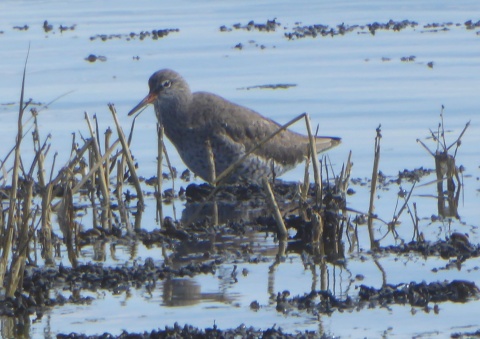
I strongly suspect the
famous Spotted Redshank of Emsworth is now winging its
way back up north towards its breeding grounds 2,000
miles away in Northern Scandinavia. It is unlikely to
make the journey non-stop, pausing at various suitable
feeding places on the way. It will be very welcome
back here in October if it makes it, though at 16+
years it is getting near the end of its life. I
wonder, is our bird the longest lived Spotted
Redshank?
I have adjusted to special Spotted Redshank web page
to indicate that this year's last sighting was 23 Mar
2019.
For all details of first and last sights go to . . .
Spotted
Redshanks at Nore Barn
Is
it the same bird?
This is a
question people often ask me . . . 'Is it the same
bird that has been coming for the past 15
years?'
My answer is that I have no definite proof as it is
not ringed or tagged. But having monitored and watched
the bird very closely and taken lots of photos and
videos of it over the past 15 years I am sure it is
the same bird for the following main reasons.
1. The arrival and
leaving dates of the Spotted Redshank are always
roughly the same - arriving mid to late October and
departing mid to late March. These dates suggest
strongly that the bird is a male as the females come
through on passage much earlier Aug-Sep. The female
leaves the nest soon after laying and leaves the male
to brood, hatch and fledge the young before leaving
himself.
2. Its timing in
the stream has been constant. It returns to the
same small tidal area which is fed by a fresh water
stream from inland. It arrives at the stream 2-3 hours
before and after high water, depending on the height
of the tide, and remains there feeding for at least an
hour each visit. It sometimes roosts on the
saltmarshes.
3. Its general
tameness in the stream is a distinguishing feature
of the Spotted Redshank. It is often referred to as
'the tame Spotted Redshank' It is so confiding
allowing close approaches with no obvious fear, though
it is always alert to anyone of thing getting too
close. It is a cinch to photograph and video. It has
been called 'A photographer's dream bird'. I have
hundreds of good images on my computer and I only use
a simple point and shoot camera. People come from far
and wide to take its photo.Surely, it must be the most
photographed Spotted Redshank in the world! It annoys
me to see photographers creeping to within metres of
the bird, often with huge lensed cameras which are
totally unnecessary. But the bird takes no notice.
4. Its feeding
behaviour in the stream in much the same way each
time. I can now spot it easily a good 50 yards away at
the end of Warblington Road. It often feeds with a
regular feeding companion - a colour-ringed Greenshank
(G+GL). Occasionally a second, or even a third,
Spotted Redshank turns up to feed with the regular
bird which it tolerates and they are often quite
friendly together. Generally, the Spotted Redshank
does not tolerate the presence of a Common Redshank,
though it is indifferent to other regular feeders in
the stream, including Mute Swans, Black-headed Gulls,
Black-tailed Godwits and Little Egrets.
3. Its tolerance to
disturbance. This is a very heavily used area for
dog walking and visitors birdwatchers are often
disturbed when they see dogs dashing into the stream
to chase the birds. However, I have learned not to
worry too much as the bird always flies off to the
saltmarshes if the dog gets too close, returning once
the unruly animal has gone. Whenever I get the chance,
and have the courage, I speak to the dog owners hoping
to impress on them the importance of not disturbing a
rare bird that has flown such a long way to spend the
winter with us. I have done my bit towards educationg
the local people to see how lucky they are to have
such a wonderful visiting their area. My policy is
always education before legislation. Local people have
certainly adopted the bird and adopt a policing policy
of their own which is good.
Other
observations
The Mute Swan
pair was still present in the stream at high water.
Will they be nesting? But where as there is nowhere
suitable.

A beautiful Peacock
butterfly was fluttering along the seawall, my
first sighting of the year. It rested in warm sun
briefly on the concrete wall enabling me to get a
photo.

I had a walk round the
woods where I heard Chiffchaff singing, but no
Blackcap. A Chiffchaff was also singing from the north
copse by Maisemore Gardens.
March
Wheatear
Peter
Milinets-Raby concentrated on the hay dump at
Warblington Farm this morning (From 9am to 10:46am):
No Yellowhammer singing which was a shame. However, he
did see a Wheatear on the hay dump along with 3 Water
Pipits and 4 Pied Wagtails.
The only other birds
of note were 2 Med Gulls over calling, 4 Stock Doves
and a Kestrel.
The warm sunshine had
brought out these buff/gold flies in their hundreds
and the hay dump was buzzing with them. They were all
displaying and mating. Brian's
Note: I think they
might be Yellow Dung Flies.

White
Stork
Caroline
French saw a White Stork soaring high over south
Thorney yesterday at around 13.00 hrs. There have been
other sightings in the Romsey area so worth people
keeping their eyes open.
SUNDAY
MARCH 24 - 2019
Wild
Daffodils
Roy Ewing and
his wife went to see the Chilgrove wild daffodils
today, but it was rather a disaster. Roy found only a
few hundred flowers, rather than the tens of thousands
he was expecting. There was a good display of
Primroses and Cuckooflowers to compensate.
They stopped off at Inholmes Wood on the way back,
always a reliable place for Wild Daffodils. One site
had just a dozen Wild Daffodils, but the other site
had zero - but hundreds of green plants with flowers
still to come.
Roy wonders if this is climate change beginning to
bite. Has anyone else noticed this scarcity of Wild
Daffodils?
Here is a photo
of some Wild Daffodils in my files taken on 28 Feb
2004.

Garden
wildlife
Sue Thomas
sent me a few pics from her garden. She says, "My
little bird feeders are pigeon proof but obviously not
Squirrel proof! But the Goldfinches came back and
found some leftovers". PS Sue is a potter and made
those feeders herself!
Sue also had a
Peacock butterfly in the garden today - nice
one.
I have yet to see one, but I did have a male
Brimstone on a pot of Primulas - see photo below.
Nice colour contrast.
Periwinkles
Walking with
the family along Emsworth east beach my attention was
drawn to thousands of tiny Periwinkles clinging to the
rocks. Peter Milinets-Raby noted a similar explosion
of these tiny creatures at Warblington on March 22.
Does anyone have an explanation for this phenomenon?

SATURDAY
MARCH 23 - 2019
Nore
Barn
I was rather
late getting over to Nore Barn this morning. I arrived
at about 11.30am with the tide already well advanced
with only 2 hours to high water. The bay and the
stream area were full of water but I guessed the
Spotted Redshank would be hanging around somewhere and
I was right. I could see Roy Ewing in the distance
looking into the stream area from the bridge and yes
he was watching the Spotted Redshank, nestling among
the grasses close to the shore. However, almost
immediately a couple of dogs dashed into the water
causing the bird to fly across to the saltmarshes
where it settled down in the grasses. This is clearly
a favoured safe high water roosting spot for the
Spotted Redshank from where it has a clear view of the
stream area.
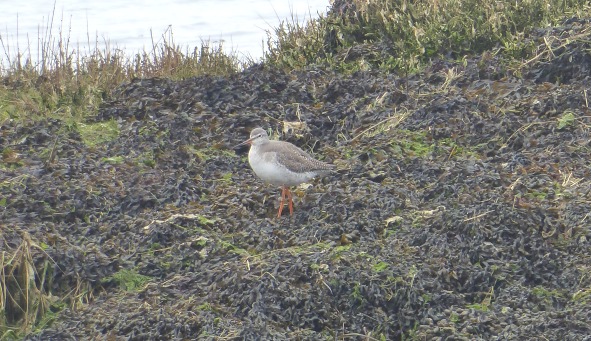
The
video clip shows the Spotted Redshank at its safe
place . . .
https://youtu.be/Q8XY_e2sNZ8
Both Roy and I had a
word with the dog's owner who was very understanding
when we explained that her dogs had just scared off a
rare bird that shortly will be making a 2,000 mile
journey to Northern Scandinavia. We impressed the
importance of controlling dogs when walking through
this area in winter as many other long travelling
migrant birds would also be feeding here. Personally,
I am a great believer in education before legislation,
so I just hope the message gets around that we all
need to take special care. In any case, I am reassured
to know that our beloved Spotted Redshank has coped
for the past 15 years with being chased by dogs and it
always comes back unscathed.
By the way Roy
mentioned that he would be putting fresh notices on
the grass roadside verge near the Warblington
roundabout where the Bee Orchids grow to warn the
Council cutting teams to give them a miss during the
flowering season. We have had up to 60 flowering
spikes in past years. Roy will do a count. Good man.
While at Nore Barn I
had a stroll through the woods listening and looking
for the Blackcap that Jo Bray had there yesterday, but
I heard nothing.
A little later at 12
noon when I got back to the stream area all was quiet
and the Spotted Redshank had returned to the grasses
near the shore to feed as shown in this
photo.

It grabbed what looked
like a small crab from the water which a Black-headed
Gull also fancied. There was a bit of a confrontation
before the Spotted Redshank flew back to its safe
place on the saltmarsh island with the prey.
See
a video clip of this
incident . . .
https://youtu.be/xB2yQblukvs
For more details about
the history of the Spotted Redshank at Nore Barn go to
. . . http://familyfellows.com/x-spotted-redshank.htm
Hermitage
Millponds
I made my way
to Slipper Millpond where I found the pair of
Canada Geese on the centre raft as reported by Pat
Atkin yesterday with the Great Black-backed
Gulls relegated to the much smaller south raft. I
assume these two pair of birds will make their nest on
these two rafts as they have done for the past two
years, but there was no sign of any nest building as
yet.
Canada
Geese on the centre raft
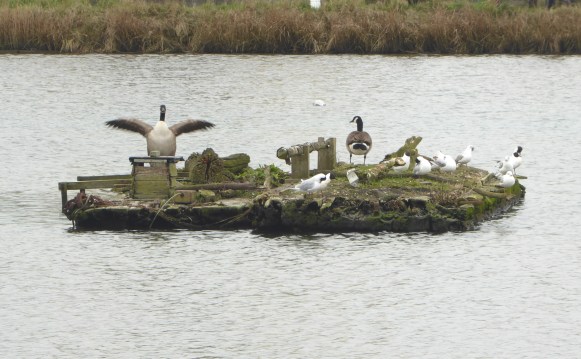
Great
Black-backed Gulls on the south
raft

For
more information about the nesting of Great
Black-backed Gulls on Slipper
Millpond
go to . . . http://familyfellows.com/millpond-great-bb-gull.htm
I crossed the main road
to have a look at the Mute Swan nest deeply
buried in the reedbeds on the west side of the pond
with the pen snugly settled on the nest. This is where
the swans successfully nested last year producing 3
cygnets. This was after their first nest (with 8 eggs
in it) on the island was swamped by high tides. I
think they have learned from last year's bad
experience!

There is a very nice
flowering of Musk Storksbill on the Hermitage
grass verge on the corner of Lumley Road.
While I was there I met a lady named Sue from
Southbourne litter picking on the side of the road.
Brendan Gibb-Gray used to litter pick this area, but I
gather is not well enough to carry on. Brendan, we
wish you well.
I met Maurice Lillie who
told me there had been a car crash in Seagull Lane. I
made my way there to have a look and found a badly
damaged and abandoned BMW car parked outside the Brook
Meadow entrance gate at the end of Seagull Lane. I
gather the car had crashed into a garden wall on the
corner of North Street and Seagull Lane at 1am last
night before careering down the lane. Police were
aware.
FRIDAY
MARCH 22 - 2019
Spotted
Redshank at Nore Barn
I got to Nore
Barn at 3pm. At 2 hours after high water the bay and
the stream were still fairly full. However, this did
not deter the Spotted Redshank from feeding quite
close to the shore with its 'friend' the colour-ringed
Greenshank (G+GL).
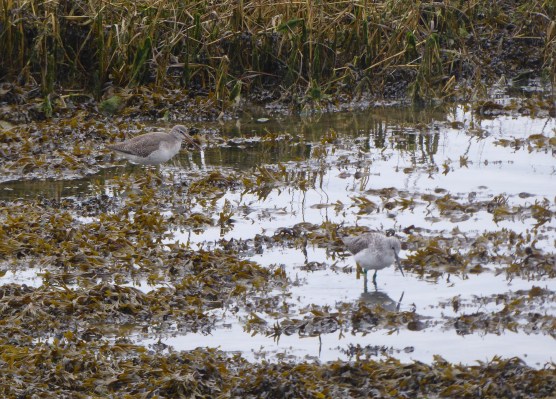
I watched them for a
while until they were disturbed by several unruly
dogs. I did not wait around, but I am fairly sure they
will be back once the dogs have gone.
The video clip shows the two birds feeding and then
the Spotted Redshank flying off . . . https://youtu.be/_6DTtqvUrs8
Today's Spotted
Redshank equals last year's final sighting which was
also on Mar 22. The next latest date is 27-Mar-13, so
let's see if it can beat that. So keep watching!
For more details about the history of the Spotted
Redshank at Nore Barn
go to . . . http://familyfellows.com/x-spotted-redshank.htm
Jo Bray and her
partner David went to Nore Barn at 9.45 this morning
and managed to locate the Spotted Redshank out in the
channel near the green marker post, next to a yellow
buoy. Here's David's 'record shot' using the 'phone
and 'scope. Nice one!

Walking back to
Warblington Jo and David heard and saw what I think is
the first local Blackcap of the year in Nore Barn
woods!
Canada
Geese at Slipper Millpond
Pat Atkin
reports that a pair of Canada Geese was back on
Slipper Millpond and that the Great Black-backed Gulls
have moved onto the south raft. This is not entirely
unexpected as Canada Geese have nested on the centre
raft on Slipper Millpond for the past two years,
displacing the Great Black-backed Gulls to the south
raft. Also Peter Milinets-Raby reported seeing a pair
of Canada Geese on the town millpond yesterday,
probably intending to move across town.
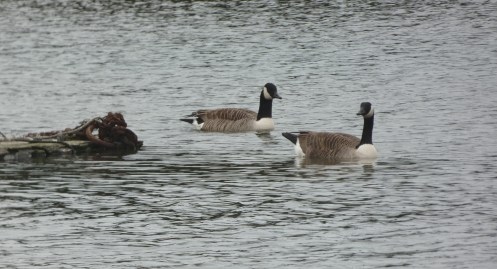

For more information
about the nesting of Great Black-backed Gulls on
Slipper Millpond
go to . . . http://familyfellows.com/millpond-great-bb-gull.htm
Yellowhammer
at Warblington
Peter
Milinets-Raby was out this morning (9am to 10:50am -
tide pushing in) to get away from yet another night of
political mayhem and stalemate! However, who would
believe that the MOD's No Deal Brexit plans and my
mornings bird watching would have something in common!
If you have not guessed, then I will put you out of
your misery, which is something Parliament should do,
but I digress. The MOD's No Deal Brexit plan has been
given the code name "Yellowhammer". Well, would you
believe it, I had a singing male Yellowhammer this
morning - the first singing bird since the turn of
this century and only the second bird I have seen on
the "patch". It was singing near to the clump of
Willows in the north east corner of the BIG field (The
one with the Hay dump and close to the footpath that
leads north to Emsworth - this has a name, but I can
not think what it is called). Great views in the scope
and a few record photos taken. Alas, I don't think it
will find a mate, but at least it is the step in the
right direction!

Other birds seen this
morning as I walked around Warblington were:
Ibis field: Chiffchaff singing, 2 Song Thrush, 2
Mallard and 3 Moorhen.
Big Hay Dump: 11 Stock Doves, 14 Meadow Pipit, 4 Water
Pipits, 2 Pied Wagtails, 1 Chiffchaff feeding on
gunge. 1 Skylark singing
Field behind Conigar Point. 204 Linnet in one very
mobile feeding flock (Counted from photos).
Conigar Point: 8 Teal, 6 Wigeon, 39 Shelduck, Male
Pintail, 3 Brent Geese, 17 Dunlin.
Loads (and I mean loads) of Periwinkles on the shore -
every stone and rock on the shore was covered with
them! An extraordinary sight - wow, millions!!! (See
photo from phone).

Off Pook Lane: 7
Shelduck, 10 Teal, 8 Red Breasted Merganser, 14 Brent
Geese, Med Gull heard several times, 2 Meadow Pipits
in SSSI field, 2 Stock Doves, 80+ Black-tailed
Godwits.
And in the distance on Langstone Mill Pond were 9 very
frisky looking Little Egrets.
THURSDAY
MARCH 21 - 2019
Brook
Meadow - Work session
Twelve
volunteers assembled at the tool store (HQ) for this
morning's work. A passer-by kindly offered to take the
group photo so that I could be in it for a nice
change!

Leader for the day,
Colin Brotherston outlined the main tasks which
included removing the various piles of tree cuttings
and fallings from around the meadow and moving the
pile of grass cuttings from the north-east corner to
make way for the flood defence bund planned by the
Environment Agency.

Video
clip of the work .
. . https://youtu.be/_OeaflGj-jQ
Two more members not
on the photo cleared an area in Palmer's Road Copse in
preparation for the planting of some Alder whips.
Colin's full report along with more photos can be seen
on the Brook Meadow web site at . . . https://www.brookmeadow.org.uk/conservation-news/
Butterbur
count
I carried out
a second count of the Butterbur flower spikes on Brook
Meadow during the work session. I could see
immediately that there were far more than last time
and so it turned out.

The work group kindly
provided me with suitable long twigs with which I
could section off the main Butterbur area for easier
counting. I did the first count last Friday 15 March
which was very low in comparison with previous years,
so I decided to do a repeat. Well, I was thoroughly
justified as today's count revealed a considerable
increase in the number of visible flower spikes from
415 to 794 since the previous count. The largest
increase by far came from the main area immediately
below the seat which went up from 352 to 704. Here is
a view of the main Butterbur area.

As shown in the chart
below this year's count is higher than the last three
years but roughly the same as that in 2014 and 2015,
but all are well below the all time record of 1,150 in
year 2013. This will be my final count as the flower
spikes are now getting difficult to see as the
surrounding grass and other vegetation grows
rapidly.
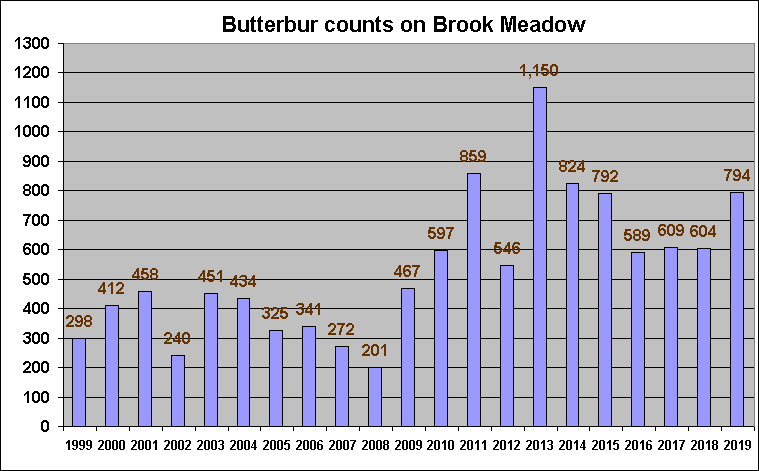
Cetti's
Warbler
Colin
Brotherston and I had the pleasure of hearing a
Cetti's Warbler in full voice coming from the bushes
on the west side of the river close to the observation
fence. This was my 3rd hearing of this distinctive
song bird this month which indicates a male singing to
establish territory and attract a mate. Let's hope it
succeeds and so establish it as a breeding bird for
Brook Meadow.
Cetti's Warbler has, in fact, been fairly regular
spring visitor over the years to Peter Pond and the
Lumley Stream area of Brook Meadow, though we missed
out completely last year. Our best year was 2010 when
one was regularly heard and seen from April through to
June and even photographed. Though very easy to hear,
Cetti's Warbler is a notoriously difficult bird to see
let alone photograph. Here is a nice shot taken by
Malcolm Phillips of a Cetti's Warbler on Brook Meadow
in January 2016.

Black
Poplars
The two large
Black Poplars are now decorated with thin yellow-green
catkins which I think are female flowers; I gather
male catkins would be fatter and red. I think these
two Poplars which were planted on the meadow in
November 2004 in memory of Frances Jannaway's mother
are hybrids, but which hybrid they are I am not sure.

The Collins Tree Guide
has a section devoted to Black Poplar hybrids, some of
which are female clones and others male clones. Of the
female clones I am tempted by 'Florence Biondi'
(p,158) from its description as straight stemmed,
graceful with fairly sparse foliage denser at the
crown, though I could be wildly wrong! I will
investigate further and will check the catkins as they
develop, just in case I have got the sex wrong. Here
is a close-up of the Black Poplar catkins.

I posted the query
onto the Facebook page 'Wild Flowers of Britain and
Ireland' and received the following reply from Mike
Crew.
"It
is still a little early but they do look like female
catkins. Give them another few days to be sure. If you
get a windy day you might find some on the ground. I
would advise getting full leaf details later in the
year, too, so that you have the whole suite of
characters to work with. Some woody plants require
several visits to determine an identification."
I thanked Mike for his helpful reply and confirmed
that I would continue to monitor the catkins to see
how they develop and also examine the leaves closely.
Spotted
Redshank
Brian Lawrence
was at Nore Barn today and saw the Spotted Redshank
feeding the stream. So it is still with us, but, going
on past experience, not for much longer. Our last
sighting last year was Mar 22nd - tomorrow! All
sightings much appreciated.
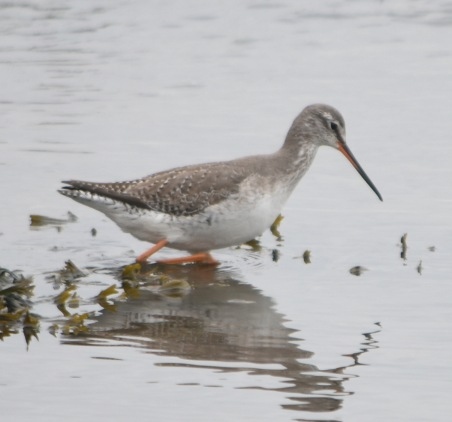
Willow
catkins
The Goat and Grey
Willows now have catkins developing. The Grey Willows
on the edge of the Lumley copse have yellow male
catkins ('pussy willows') and the Goat Willows on the
east side of the north meadow with green female
catkins. I should point out that these two willows
have been previously identified from their bark and
not from the catkins which can be either male or
female in both species.
Male
Grey Willow Catkins . . . . . Female Goat Willow
catkins
WEDNESDAY
MARCH 20 - 2019
Bluebells
in Ashling Wood
Having spent
the morning doing my volunteer room stewarding at the
Pallant Gallery, I decided to head for Ashling Wood to
see if there were any early Bluebells out. Ashling
Wood is always my first port of call for Bluebells.
Parking by the side of the road from East Ashling to
West Stoke I made my way along the footpath through
the wood where Wood Anemone and Dog's Mercury were
abundant. Then I started to pick out the blue flowers
of Bluebells, first one or two then more and more.
There's not many as yet, but lots more to come. They
should be at their best in a couple of weeks. They are
usually well out by the end of March.

Sadly, as I noted last
year, the large Rookery at the entrance to Ashling
Wood has gone. It is not unusual for Rooks to relocate
their nesting colonies, but this one had been here
since, at least 2007.
Bowhill
I took the
single track road towards Funtington mainly to check
the embankment outside the entrance to Bowhill House
which is always particularly good for Hairy
Wood-rush (Luzula pilosa) of which there was
plenty today. (Grid Ref: SU 81625 08923). There was
also lots of Dog-violets - but which one - Early or
Common? Mostly they had dark spurs notched at the end.
Some were white.
Also on the embankment
one of the large Horse Chestnut trees had just burst
its sticky buds.
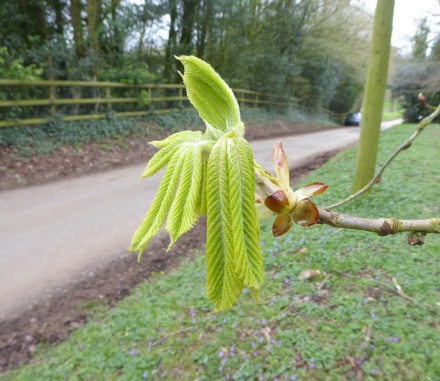
Woodend
I walked the
short distance down the road to Woodend where I noted
at least three substantial trees with an abundance of
catkins and leaves just sprouting.

I could only find one
type of catkin (male?) from which I would tentatively
suggest Grey Poplar.

Marlpit
Lane
I called in at
Marlpit Lane on the way home to see how the
restoration work on the old gravel pits to the east of
the lane was going. The machines were still at work on
the site.

But the work looks as
if it is near completion with the what was formerly a
vast area of undulating hills and dips now a flat
area. The plan I gather is to sow with grass seed for
grazing.

I had a mooch around
the more 'weedy' area to the east of the restored
plain which was full of interest. My first Ground-ivy
of the year was not a surprise.

But I was flummoxed by
several plants including this fleshy type of Lupin. I
shall return to this area to see what turns up.
Jill Stanley tells me these plants are Cerinthe
major, a garden plant that belongs to the
Borage family.

Garden
Stock Doves
When I got
home I found a pair of Stock Doves feeding happily on
the grass in the back garden. Interestingly, they only
seem to turn up in the garden at this time of the
year.

Birds
in Emsworth Harbour
Peter
Milinets-Raby visited Emsworth this morning, just for
an hour (9am to 10am - tide pushing in). There was
very little around and it was a real squeeze to tease
any birds out!!
Nore Barn: At the least the Spotted Redshank
was still in the stream. As you said yesterday, not
many days left for this bird before it ventures
north!
Also of note were 9 Brent Geese, 4 Teal, 2 Lesser
Black-backed Gulls, 3 Shelduck, 6 Turnstone landed on
one of the boats to roost and in the distance 10 Mute
Swans (with 2 in the stream outflow). There was also a
Chiffchaff singing in the wood.
Beacon Square: 4 Teal, 7 Brent Geese, 9 Shelduck, 3
Great Crested Grebes feeding close in (see photo), 3
Lesser Black-backed Gulls and on the salt marsh were 2
Canada Geese.

Emsworth Harbour: 3
Little Grebes, 8 Med Gulls, 6 Brent Geese, one Great
Crested Grebe and two very noisy and mobile Canada
Geese. These two could be the pair that may settle on
Slipper Mill Pond?
TUESDAY
MARCH 19 - 2019
Nore
Barn
I got to Nore
Barn at exactly 12 noon two hours after high tide,
with the bay and stream still fairly full of water.
Immediately I spied the famous Spotted
Redshank, which I missed yesterday, busily feeding
in its customary fashion among the seaweed and
saltmarshes along the edges of the stream. What a
cracking bird! And to think it has been coming to this
same feeding spot for the last 15 years. Astonishing!
I echo Peter's comment below that the harbour is
almost deserted of wintering birds - apart from the
Spotted Redshank that is!

Here is a little video
I made of my friend on the shore immediately in front
of me. . . https://youtu.be/qiGjopdUvxM
On the basis of past
records I suspect the Spotted Redshank will leave Nore
Barn anytime within the next week to wend its way back
to its breeding grounds in Northern Scandinavia. So I
bid it a fond fare well this morning just in case this
was my last sighting. See you again for the 16th year
this coming October maybe? Fingers crossed for both of
us!
Slipper
Millpond
From Nore Barn
I went over to Slipper Millpond to have a look at the
other star birds of Emsworth, the Great
Black-backed Gulls. These two magnificent birds,
which have been nesting on the pond for the past nine
years, were on the water while I was present keeping
well clear of the resident pair of Mute Swans
which usually nest on the adjacent Peter Pond. I know
there has been friction between these pairs of large
birds in the past, but they have always managed to
nest and bring up their youngsters without too much
bother. Interestingly, there has been no sign of the
pair of Canada Geese which for the past two
years has ousted the Gulls from their traditional
nesting site on the centre raft.
Here
are shots of the two Great Black-backed Gulls. Female
on left and male on right (I
think)
Langstone
Mill Pond
This morning
Peter Milinets-Raby had a quick visit to Langstone
Mill Pond 9am to 10:15am - high tide.
There was an element of spring in the air with at
least 4 Chiffchaff seen and singing (see
photo).
A couple of Little
Egrets were prospecting the Holm Oak and though not a
pair per se, one bird was displaying with a ruffle of
its beautiful plumes and making lots of guttural
calls.
The Grey Herons
were in full swing with lots of stick carrying and
feeding. One adult came in with a HUGE stick, at least
twice the size of the bird itself (See photo)

Below is a breakdown
of the heronry:
Nest One: Four very active and inquisitive teenagers
standing up in the nest. Lots of wing flapping (see
photo)

Nest Two: Impossible
to see this nest. Two fairly well grown young just
visible as the adult came in with food (see
photo)

Nest Four: Bird very
interested in something in the nest. I think there are
tiny chicks in this nest
Nest Five: Adult sitting low and tight on the nest
Nest Eight: Adult sitting tight on nest and other
adult constantly bringing in sticks
Nest Eleven: Adult sitting on nest
Nest Thirteen: Adult sat on nest
So a total of seven nests up and running and three of
them with young!
The only other birds
of note on the pond were 2 pairs of Tufted Duck.
Off shore were 2+ Med Gulls, 82 Brent Geese, 4 Red
Breasted Merganser, 7 Wigeon and on the last bit of
island before the tide swallowed it were 8 Grey Plover
and 4 Dunlin. Its amazing how the winter birds have
vanished very quickly over the last
fortnight!
The horse paddock held
up to 4 Grey Herons collecting sticks and a tightly
packed roosting flock of 148 Black-tailed Godwit, 5
Wigeon, 50 Teal, 6 Moorhen, a Stock Dove and a Grey
Wagtail. Also 1 Meadow Pipit flew over
north.
News
from Cuba
Malcolm
Phillips who now lives in Cuba has sent me a photo of
another species of Heron that we are very unlikely to
see on Langstone Mill Pond, namely a Black-crowned
Night Heron. A fairly common resident in Southern
USA and the Caribbean, it migrates north in summer as
far as Canada. I recall having had a couple of
sightings of this cracking bird on the St Lawrence
Seaway near Montreal in the summers of 2000 and 2002.

Malcolm will be
raising the public profile of his excellent wildlife
photos with an exhibition of them in the local art
centre. He says it opens 5th April 9.30pm with
government officials and TV on site. So, if you happen
to be in Cuba pop in and say hello!
MONDAY
MARCH 18 - 2019
Nore
Barn
I visited Nore
Barn this morning on a falling tide mainly to check on
the Spotted Redshank which has not been
reported for over a week. I stayed for about an hour,
but it did not turn up despite the conditions in the
stream being ideal for the bird. There was no sign of
its feeding companion the colour-ringed Greenshank
either.
It is likely that our Spotted Redshank has already
have left for its breeding grounds in Northern
Scandinavia, though my last sighting last year was on
Mar 22, so I will need to check again later in the
week.
Meanwhile see the special Spotted Redshank web page
for details of all first and last sightings since it
was first recorded 15 years ago in Dec 2004 at . . . .
Spotted
Redshanks at Nore Barn
I was interested to
see what was clearly a pair of Mute Swans
swanning around in the stream probably looking for a
potential nesting site. Sadly, with so many dogs
around there is nowhere safe in the Nore Barn area for
them.

While waiting for the
tide to fall I had a stroll around the woods where I
noted a large amount of tree cutting with the cuttings
piled up around the northern edge of the woods to
restrict access from the north path. I did not hear or
see anything of special interest, but I could not
resist taking a shot of this beautiful
Blackbird which was serenading the arrival of
spring!

Langstone
Mill Pond
Peter
Milinets-Raby had a late morning visit to Langstone
Mill Pond and Warblington 11:52am to 2pm - tide going
out. His report follows . . .
Pond: Grey Heron Nest
4: Has tiny young - I could not see them, but I could
hear them and watched an adult bird regurgitate fish
into the nest. It had a huge fish (the length of its
bill) that it re-swallowed as it was obviously too big
for the chicks.
Elsewhere on the pond the Mute Swan pair were busy
building up the nest by the small bridge adjacent the
heron watch point, a pair of Wigeon, a singing
Chiffchaff and a singing Reed Bunting.
In the flooded horse paddock were 3 Black-tailed
Godwit, 30 Teal, 10 Wigeon, 4 Grey Herons, 6 Moorhen
and circling over the rear was a Buzzard.
Off shore were 2 Shelduck, 4 Med Gulls, 66 Brent
Geese, 133 Black-tailed Godwit, 22 Teal, 6 Red
Breasted Merganser and a Great Crested Grebe. Meadow
Pipits were noted moving inland with 9 recorded.
Warblington (12:45pm to 2pm): The field to the west of
the cemetery held 11 Little Egrets.
Old hay dump: 1 Meadow Pipit.
Big Hay dump: 4 Water Pipits (see photos), 1+ Meadow
Pipits, 5 Pied Wagtails, 1 Stock Dove. There was a
very active Chiffchaff singing its heart out in the
Ibis field hedge
For
the previous entries go to . . March
1-16